How can I heat my home in Japan more comfortably and efficiently?

Because Japanese homes are generally not equipped with central heating or thick insulation, your first winter in Japan might be chillier at home than you would expect. Luckily, there are many different household heating options available in Japan, but these vary in terms of efficiency, cost, and comfort. Here, we explore the best ways to keep your home happy and warm throughout the winter without breaking the bank.
What is winter like in Japan?
If this will be your first time living in Japan, you might be in for a few surprises in terms of the climate.
As any Japanese travel brochure (or any person of a certain age you speak to in Japan…) will proudly proclaim, Japan is “a country of four seasons” (四季の国). Even Japanese literature, particularly poetic forms such as haiku, places a heavy emphasis on symbolism and atmosphere of the different seasons. How true this is somewhat debatable and obviously depends on where you live in Japan (it rarely snows in Tokyo, for instance, and never in Okinawa!) but what is true is that the changes between seasons can be quite sudden. It is not uncommon for a late September typhoon to come in and blow away the humid heat of summer, sending the country into autumn in a single day!
Sample of Average Seasonal Temperature Ranges Around Japan
| Spring (Apr-June) | Summer (July-Sept) | Autumn (Oct-Dec) | Winter (Jan-Mar) | |
|---|---|---|---|---|
| Tokyo (Honshu) | 10°C-25°C | 26°C-36°C | 5°C-23°C | 0°C-14°C |
| Fukuoka (Kyushu) | 11°C-27°C | 22°C-33°C | 6°C-24°C | 4°C-15°C |
| Sapporo (Hokkaido) | 3°C-22°C | 19°C-26°C | -4°C-16°C | -7°C-0°C |
| Naha (Okinawa) | 18°C-30°C | 25°C-33°C | 16°C-28°C | 18°C-30°C |
In terms of regulating the temperature in your home, the two seasons that you need to think about the most are summer and winter.
While at a glance summer temperatures around Japan might seem warm but not too extreme, the humidity that descends upon most of the country in summer can be quite the sweaty shock to those who have never experienced it before! Stores sell clothing and bedding designed especially to keep you cool and air conditioning is an absolute necessity. You might also be surprised to see women strolling around carrying umbrellas (日傘, higasa) in the brilliant sunshine!
Air conditioning units in Japan blow hot and cold… Japanese air conditioning units are generally rectangular wall-mounted devices that are connected by a thick hose to a large fan unit outside your home. You cannot install or remove these units yourself (a technician must visit).
Because very (very) few homes in Japan are equipped with central heating (or cooling) systems, these wall-mounted units are very common sources of both air conditioning in the summer and heating in the winter. Just click the 暖房 (heat) button on your air-con remote control for warm air or the 冷房 button for cold air. There is also a useful dehumidifying function (除湿) that is really useful when the weather is not too hot but still very humid.
Winter in Japan varies considerably based on your location, given the country’s incredible north-south length (3800 km!). If you are living in semi-tropical Okinawa, you don’t need to worry too much, even in winter! Tohoku, Hokkaido, the Japan Alps, and the Japan Sea coast are all very cold and see plenty of snow. The major cities along the coast facing the Pacific Ocean (Tokyo, Yokohama, Nagoya, Kyoto, Kobe, Osaka, etc.) rarely see snow, but they do get pretty chilly, especially between January and early March.
Compounding this chilly winter weather is the absence of significant insulation, double-glazing, or central heating in the vast majority of Japanese homes. Interior heating is usually provided by individual standalone heating appliances, making it more practical (and economical!) to heat only a single room at a time, turning off heaters whenever their rooms are not being used. This is especially true if you are living in a larger house, which would be very expensive to heat with spot heaters, or an older house, as these tend to be quite cold and drafty. This is also one reason why Japanese homes sometimes have heated toilet seats, quite a novelty to many new residents of the country but one that they soon learn to love!
Other ways to stay warm in a Japanese house or apartment… You may also want to rethink the clothing that you wear around the house. Japanese clothing stores abound in warm and comfortable pajamas, slippers, and “roomwear” (clothes to wear around the house) during fall and winter seasons. Conversely, they also carry an astonishing variety of clothing that keeps you cool in hot weather to be worn around the house during the hot summer months.
Investing in seasonal bedding is also a good option in Japan. You can purchase specially designed warm blankets, duvets, pillow-cases and bed-pads for winter as well as their cooling equivalents for summer.
If storage space is an issue in your home, you can also purchase large plastic storage bags that can be sealed airtight using any standard vacuum cleaner. This is a space-efficient and sanitary way to store unneeded clothing/bedding in the off-season. There is even a word in Japanese (衣替え, koromogae) that refers to the process of storing away last season’s clothing and getting out clothing for the upcoming season.
All this may seem unnecessary or unusual to you at first, but if you want to be more comfortable in your Japanese home while saving money on your gas bills, take your lead from the locals when it comes to clothing and bedding!
Heating Appliances
No matter how many sweaters or slippers or blankets you buy, however, you won’t enjoy your winter without some way to heat your house.
Because of the general absence of central heating, however, there are quite a few options. This article therefore runs through the main options for heating your home and compares them in terms of efficiency, cost, and comfort.
Which home heating appliances are available for the winter in Japan?
The main options for heating your home covered in this article fall under the following categories of home heating appliances:
- Wall-mounted air-conditioning units
- Gas fan heaters (spot heaters)
- Kerosene heaters (spot heaters)
- Electric carpets
- 炬燵, kotatsu (traditional low Japanese tables equipped with blanket and heater)
- Oil heaters (electric radiators filled with oil)
All these appliances heat your home in slightly different ways in terms of the area that they can heat, their range, and how much they cost to run.
Choosing a heater for your home in Japan - Key Points to Consider
Summer is a simpler season for choosing appliances: essentially the choice is either wall-mounted air conditioning units or fans (or both).
Winter offers a more diverse range of appliances, making your choice a bit more difficult. The three key points to consider are the method your appliance uses to heat the room, the size of the room to be heated, and the amount of fuel or electricity necessary.
Method of Heating
There are essentially two methods for heating a room in your house:
- convection heating - warms the air and circulates it through the room using some sort of fan.
- radiant heating - heats the nearby air around it within the range of infrared rays (hence sometimes appliances using this method are referred to as “spot heaters”).
Heaters that employ the radiant method of heating are useful to quickly warm up a small area right after you get home. After a while, however, they tend to get too warm, making it more comfortable to then switch to a convection heater that can maintain a relatively consistent temperature over many hours.
Heating Methods of Different Home Heating Appliances
| Convection Heating | Radiant Heating |
|---|---|
| Air-conditioning units Gas fan heaters | Kerosene heaters Electric carpets Kotatsu Oil heaters |
Size of the Room to be Heated
The size and shape of the room being heated should be considered when choosing which heating appliance(s) to use.
For smaller rooms such as bedrooms, it should be perfectly fine to use a small radiant heater turned down low (especially in conjunction with warm clothing and blankets).
For larger rooms such as the living room, a convection heater will heat the room more consistently and uniformly, making it more comfortable particularly when multiple members of the household are sharing the room. However, if you are alone and stationary (watching TV, reading, working, studying) for a period of time, a radiant heater can provide perfectly adequate heat.
Heaters on the move… While describing most heaters sold in Japan as “easily portable” might be a bit of stretch, there are certain types (mostly radiant spot heaters) that can be moved from room to room within your house without too much bother. Oil heaters come with wheels attached and some heaters may be light enough to carry.
However, please exercise CAUTION when moving heaters, particularly gas-powered heaters, especially if your house has steep stairs or other obstacles. It is probably a prudent move to dissuade younger members of your household from moving such appliances (or touching them at all…).
Amount of Fuel/Electricity Used
The 6 different types of heaters covered in this article use different power sources: electricity (kWh), city gas (㎥) and kerosene (L). The unit used to measure their heat output is kcal.
| Fuel/Power Source | Heat Produced per Unit | Heat Produced per ¥1 |
|---|---|---|
| Electricity kWh | 860kcal/1kWh | Approx. 31.8kcal |
| City gas(㎥) | 9818kcal/1㎥ | Approx. 65.45kcal |
| Kerosene(L) | 8771kcal/1L | Approx. 87.71kcal |
The average cost per ¥1 has been calculated here based on the following rates:
- Electricity: 1kWh = ¥27
- City gas: 1㎥ = ¥150
- Kerosene: 1 tank (18L) = ¥1800
Based on the above data, it can be clearly seen that kerosene produces the largest amount of heat (kcal) per ¥1, followed by city gas and then electricity. The heat produced per ¥1 for electricity is only about half of that produced by city gas and only around a third of that produced by kerosene, so this should be factored in when choosing your home heating appliances.
Home heating appliances in Japan - Advantages/Disadvantages
Now that we are aware of the 3 main points to consider, let’s take a look at some of the advantages and disadvantages of each of the 6 different home heating appliances covered in this article.
Wall-mounted air-conditioning units
| Advantages |
|---|
|
| Disadvantages |
|
Because wall-mounted air-conditioning units are powered by electricity, you might think that they are not very energy efficient. However, because air conditioners do not directly use electricity to heat the air, they are actually highly energy efficient.
These air-conditioning units function using heat pump technology, which involves collecting heat from the air in the room, compressing that air, and blowing that heat back into the room with a built-in fan. This heat pump technology allows air-conditioning units to multiply their energy efficiency (Coefficient of Performance, COP) by a factor of 5. What this means in practice is that if (as per the table above) 1 kwH typically produces 806 kcal of heat, a unit using heat pump technology would produce 4,300 kcal of heat (5 x 806 kcal). This in turn would put the amount of heat produced per ¥1 at approximately 160 kcal, nearly twice that of kerosene.
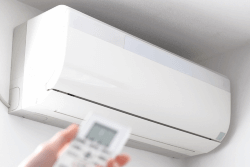
In short, this means that wall-mounted air-conditioning units have the advantages of being very efficient heating appliances and are especially suited to heating large rooms for longer periods of time, as they use convection heating and thus can achieve fairly consistent temperatures.
The main disadvantage of air-conditioning units is their tendency to dry out the air in a room, which can have negative effects on your skin and nasal passages. It is therefore best to use a humidifier when you use your air conditioner.
Gas-fan heaters (spot heaters)
| Advantages |
|---|
|
| Disadvantages |
|
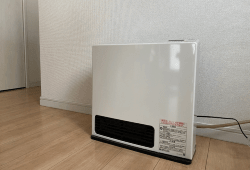
Because city gas is second only to kerosene in terms of fuel efficiency, gas-fan heaters that use city gas are a fairly economical option. There is also no need to constantly refuel gas-fan heaters, an advantage compared with appliances like kerosene heaters.
However, as with air-conditioning units, gas-fan heaters tend to dry out the air in a room. A further disadvantage is that they tend to blow hot air outward directly, which may bother some people. Also, while they do use convection heating, they tend to produce rather uneven warmth throughout a room.
Kerosene heaters (spot heaters)
| Advantages |
|---|
|
| Disadvantages |
|
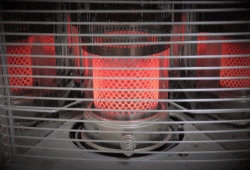
Because kerosene heaters utilize kerosene as fuel, they possess excellent fuel efficiency and are thus very cost-effective. Because they actually create a flame, you can also use them to boil water or cook rice cakes.
You must guard, however, against the risks they pose. Kerosene heaters can cause burns or even start housefires (if used improperly), particularly a concern if you have pets or small children. Another risk is the danger of carbon monoxide poisoning due to incomplete combustion, so make sure to air out the room for 2-3 minutes per hour.
Danger! Never leave a kerosene heater on when you’re out of the house.
Electric carpets
| Advantages |
|---|
|
| Disadvantages |
|

An electric carpet is not a particularly efficient heating appliance in terms of cost as it directly generates heat using electricity and this heat soon escapes the carpet. They are also limited in terms of how much area they can heat. However, it is very easy to use as it warms up quickly and maintains its temperature. An electric carpet does not dry out the air in the room and poses little to no risk of fire or burns, meaning that it is a decent option if you have pets or small children.
Kotatsu (traditional Japanese low table with blanket and heater)
| Advantages |
|---|
|
| Disadvantages |
|
A kotatsu (炬燵) is a traditional Japanese table equipped with a heater underneath and a thick blanket (or futon) hanging down from the table’s edges to the floor. In the old days, the heat underneath the table was generated by a charcoal brazier, but this has now been replaced by an electric heater. Kotatsu are a very particular cultural feature to Japan; the image of a family in winter huddled around the kotatsu with their legs under the blanket is a quintessentially Japanese one. Kotatsu figure prominently in Japanese literature and film, including one extremely notable appearance as a clue in the murder mystery novel The Devotion of Suspect X by celebrated author Keigo Higashino.
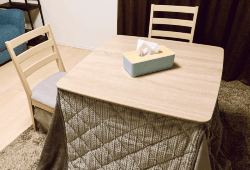
Like electric carpets, kotatsu generate their heat using electricity, but because the blanket holds in much of the heat, less energy is required to maintain a steady temperature. This makes a kotatsu an efficient heating device if you will be staying in one place (i.e. at the table) for quite some time. There is obviously no need for refueling or much in the way of maintenance, so it is quite easy to use.
However, for those who did grow up in a culture where sitting on the floor (or on cushions on the floor) for long periods of time, a kotatsu may not be the most physically comfortable option. They also tend to take up a fair amount of room (though different sizes are available) so you might want to find one that doubles well as a table for the warmer months (unless you have sufficient storage space available).
Oil heaters (electric radiators filled with oil)
| Advantages |
|---|
|
| Disadvantages |
|
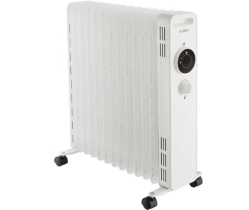
An oil heater is a type of electric radiator that gets its name (which is somewhat confusing!) from the fact that its interior is filled with oil. Its power source, however, is electricity, which is used to heat up the oil inside to generate radiant heat. Oil heaters have the advantages of requiring no replenishing of fuel along with reducing the danger of burns or fires (though you should still be careful if you have pets and small children, and refrain from the temptation to dry clothing on your oil heater!).
Oil heaters also do not blow out hot dry air, so they do not dry out the room. For this reason, many people in Japan switch off their air-con units at night and use oil heaters in their bedrooms to keep themselves warm while they sleep.
The main disadvantage is cost, which is higher than most other similar spot heaters due to the use of electricity. It is similar to the cost of an air-conditioning unit (but obviously an oil heater cannot be used to cool your house in summer!). They also only heat up the area around them, but this is generally sufficient in Japanese houses where rooms tend to be relatively small.
A bath before bedtime… Japanese bathrooms usually contain a shower and a (small but deep) bath. Conventional practice in Japan is to shower first to get clean and then soak in the bath to relax.
Because filling up the bath and emptying it for each person would be time consuming and onerous (and energy inefficient/expensive!), it is normal for members of a household to use the same bath water (after showering clean first, of course), often in the evening in fairly quick succession. Be sure to use the bath cover between bathers to seal in the warmth and reduce energy costs!
Baths are generally connected to a touch panel that allows you to fill up the bath automatically at a pre-set temperature.
If showering/bathing in the evening seems strange to you culturally, that’s fine of course. However, it’s worth a try! One, it can help you feel warmer and more comfortable before bed and help you fall asleep more easily. Two, it is more sanitary to wash off all the dirt and sweat accumulated throughout the day before climbing into bed!
Choosing a heater for your home in Japan: Comparison of Appliances
Here is a table that simplifies the advantages and disadvantages of all 6 types of home heating appliances to help you compare.
| Air Con | Gas-fan Heater | Kerosene Heater | Electric Carpet | Kotatsu | Oil Heater | |
|---|---|---|---|---|---|---|
| Value for Money | ◎ | 〇 | 〇 | △ | 〇 | △ |
| Safety | ◎ | 〇 | △ | ◎ | △ | ◎ |
| Dry Air | △ | △ | △ | 〇 | 〇 | 〇 |
| Speed | △ | ◎ | ◎ | 〇 | 〇 | 〇 |
| Consistency | ◎ | 〇 | △ | ◎ | 〇 | ◎ |
| Low Maintenance | 〇 | △ | △ | ◎ | 〇 | 〇 |
◎ = Excellent 〇 = Adequate △ = Some Concerns Involved
This table gives the approximate cost (/hour) of using each appliance. These are estimates designed to be used for rough comparisons (price/kWh varies between companies and actual usage varies between different sizes/makes/etc.) to help you with your decision.
| Home Heating Appliance | Approx. Cost of Heating (/Hour) |
|---|---|
| Air-conditioning unit | ・Min. power ¥2.8 - Max. power ¥53.5 ・Standard power consumption = ¥18.63 |
| Gas fan heater (ceramic fan heater) | ・Low fan ¥17.3 - Strong fan ¥31.6 |
| Kerosene heater | ・Low ¥1.7 - High ¥3.5 + Kerosene fuel cost ¥7.6 - ¥38.8 |
| Electric carpet | ・Medium ¥4.9 - Strong ¥7.2 |
| Kotatsu | ・Low ¥2.2 - High ¥4.6 |
| Oil heater (electric radiator) | ・Min. power ¥8.1 - Max. power ¥32.4 |
Rather than using either of these tables to try to choose one home heating appliance for all situations, the best approach could be to combine two or three appliances for maximum efficiency, value, and comfort. For example, purchasing a gas-fan heater or kerosene heater could allow you to quickly heat up a small area in your home after you return home, for example, before switching to an air conditioner to maintain a steady temperature throughout the room.
Now, is there another way to cut down on those pesky energy bills even more…?
Another way to keep heating costs (especially electricity bills) down in winter
Aside from doing your best to cut down on unnecessary electricity usage and carefully selecting the right home heating appliance(s), there is another way to reduce your electricity bills: changing your electricity provider to a company with cheaper per unit rates. Both monthly base rate charges and per unit (kWh) charges vary from company to company, particularly per unit (kWh) charges. Simply changing to a company with lower rates can save you a considerable amount of money.
This is especially true in winter when electricity bills tend to shoot up. Now you might think that winter electricity bills might not differ too much from bills during Japan’s hot humid summers, due to the need to run air conditioners all day long. However, because of the greater difference between outdoor and indoor temperatures in winter, electricity bills in winteractually do tend to be higher.
In summer, even if it is a very hot day (say, 35℃) and you set your air conditioner to cool to the recommended temperature (27℃), the difference is only 8℃. On the other hand, even on a comparatively mild winter’s day (say, 5℃), if you set your air conditioner to heat to the recommended temperature (20℃), the difference would be 15℃, which means that far more energy would be required in winter and thus your electricity bills will be higher as a result.
Heating your home in winter takes more energy than cooling it in summer… ・Summer: Outside Temp. (35℃) - Recommended Air-Con Temp. (27℃) の差 → 8℃
・Winter: Recommended Air-Con Temp. (20℃) - Outside Temp. (5℃) → 15℃
Recommended Electricity Provider: Octopus Energy
Our recommended electricity provider is Octopus Energy, one of the new electric power companies providing cheaper alternatives to traditional major electricity companies such as TEPCO.
Octopus Energy matches the base rate charges of the providers but offers cheaper per unit prices that are highly competitive with other new alternative electricity providers.
For example, for a 1 person household in the Kanto region, other new alternative providers tend to offer rates that are on average 2% lower than those of TEPCO, while Green Octopus beats TEPCO’s rates by approximately 4%. For a 3-5 person household in the same region, average savings with other alternative providers hover at around 7%, but Octopus once more offers greater savings at approximately 8% of TEPCO’s rates.
The company also has an impressive focus on promoting renewable energy and is constantly working to provide more environmentally-friendly electricity.
If you are interested in switching to Octopus Energy, your best option as always is to contact Selectra Japan (0120-164-006) for a free consultation in English so that we can help you get registered (registration with Octopus directly is only currently available in Japanese). Give us a call and we’ll help you save money on your electricity bills!
